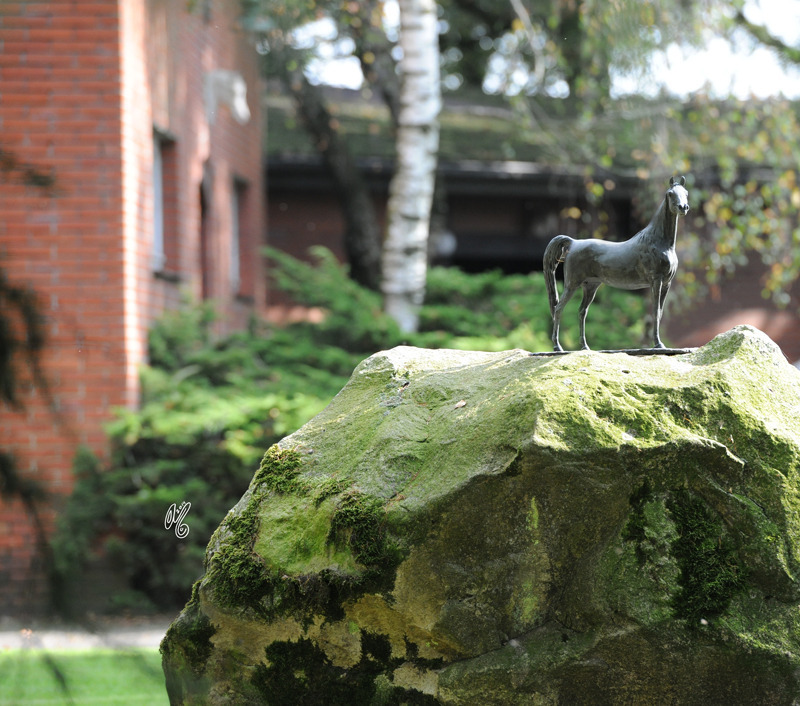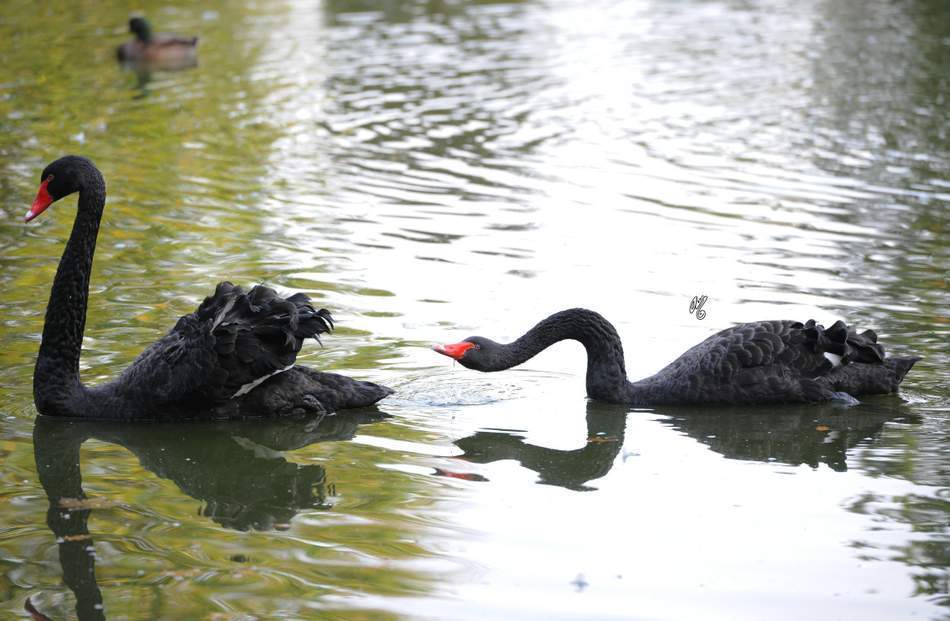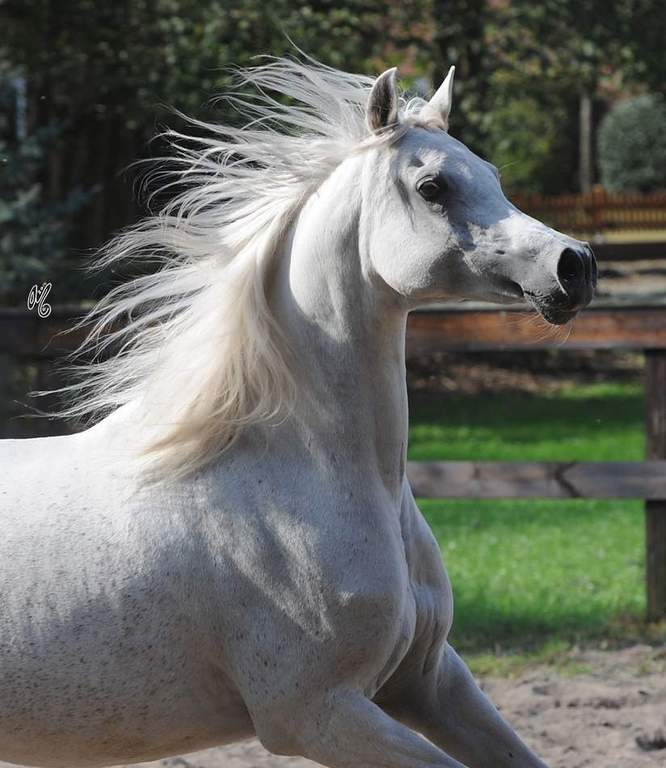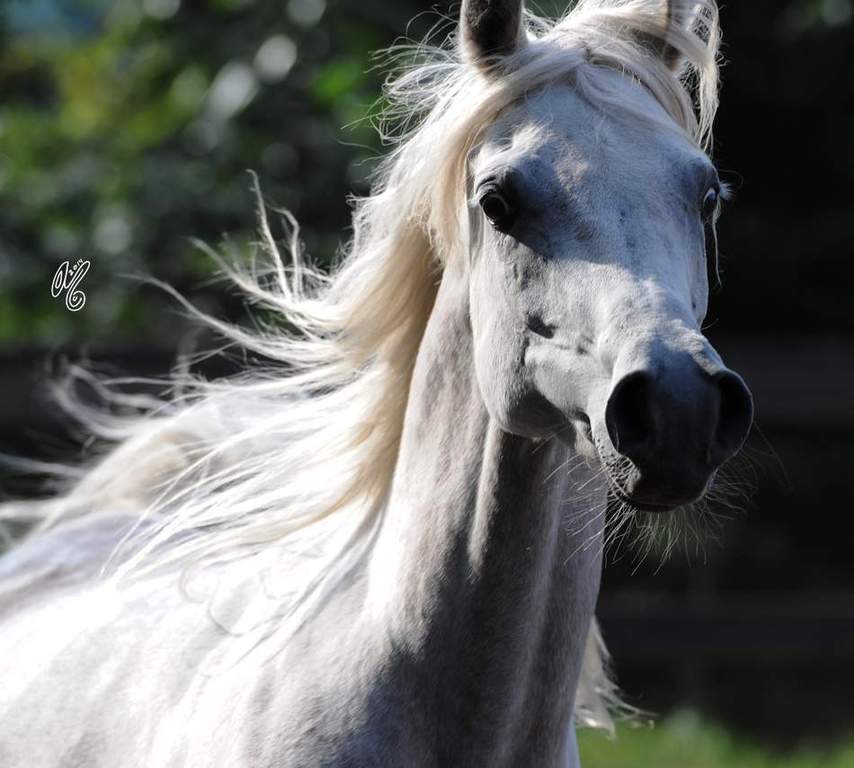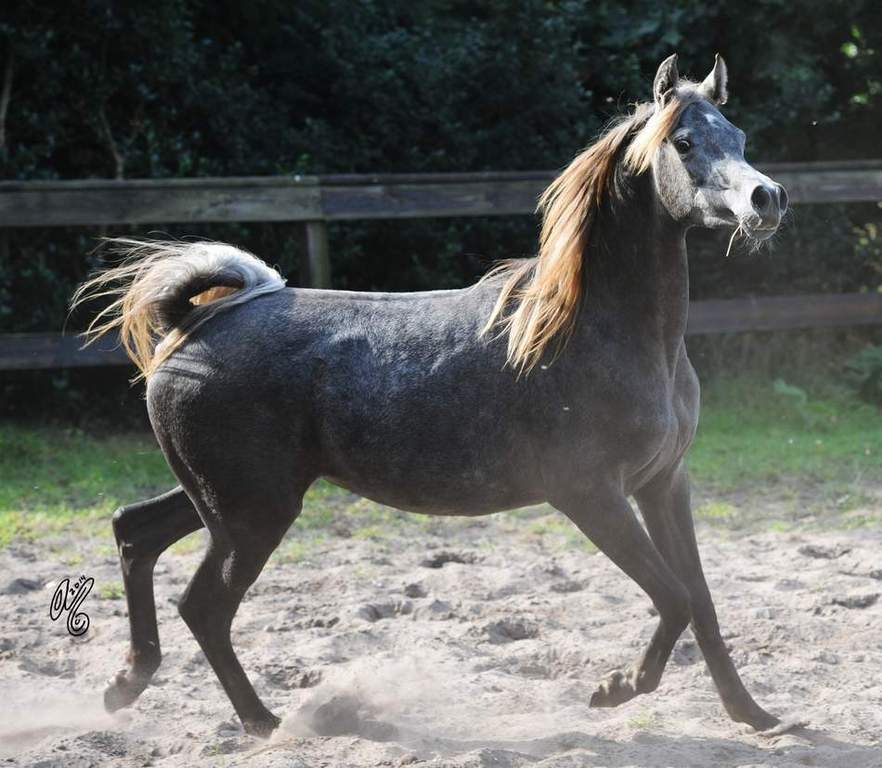My Morning with Dr. Nagel
My Morning with Dr. Nagel
by Lisa Abraham
(In anticipation of the 2015 All Nations Cup in Aachen, Germany, I wanted to share a wonderful experience that took place just after the 2014 show. This article was originally published in The Source: Volume 3: Fall/Winter 2014-A Publication of The Pyramid Society. It is being republished with kind permission of The Pyramid Society and Arabhorse.com)
Katharinenhof Stud is home to the famous NK herd. It is located in Northern Germany, about 45 minutes from the city of Bremen, which is where Dr. Hans Joachim Nagel resides with his wife Nawal. The farm is comfortably situated in a serene country setting that has become an international destination of interest for Arabian horse breeders. When entering the peaceful, wooded drive, one would never know that visitors from all over the world have traveled that same path to see the horses that belong to one of the world’s most influential breeding programs.
The farm is meticulously manicured and decorated, with art of many forms tastefully woven into the landscape’s tapestry. Dr. Nagel refers to himself as a gardener and his love of nature is reflected in the carefully placed plants and trees of various types. It was delightful to see the roses which were still in full bloom despite it being late September. His appreciation for detail was also evident as he told me stories about where he acquired certain decorative items. When he purchased the farm, it had only one building. Since then he has added several functional structures that have enhanced the beauty of the property.
Judith Forbis, of the internationally-famous Ansata Arabian Stud has shared not only a friendship with Dr. Nagel, but also a vastly influential breeding relationship. Judith shared, “For many years I watched the development of Dr. Nagel’s charming and beautiful farm. The first time Don and I went there was to see the stallion Jamil in the early 1980s. It was snowing, and I will always remember that beautiful white horse stepping out of the red brick stallion barn into the glinting white--his big black eyes were a stark contrast to the silvery backdrop. The farm was still in its early stages of development, but one could feel the visio n and purpose behind its construction.
n and purpose behind its construction.
"Over the years we became good friends and Don and I had many opportunities to watch the farm’s evolution--the colorful rose garden; the small lake he constructed for his black swans and numerous water fowl; and the additional red brick barns built in the style of that region were warm and inviting within. I never tired of visiting as there was always something new—new foals; new flowers and trees; and horses running free while we sat on the terrace and enjoyed the show they put on for us.
"Dr. Nagel has maintained his vision for breeding beautiful Arabians and his eye for beauty is reflected in all of his surroundings. During one of my visits we took a walk in the Bremen square where all types of vendors were selling their wares. We always stopped for sausages topped with hot German mustard, and then went on to the flower stalls. I bought him a beautiful yellow rose bush as a small contribution to his garden, a token remembrance of the cooperation between Ansata and his farm, and the beauty reflected in the foals by Jamil and our Ansata Halim Shah during our joint lease agreements in the 1980s.”
My visit was on Monday, September 29th, 2014—directly following the All Nations Cup in Aachen. If it isn’t every breeder’s dream to visit Katharinenhof Stud—it should be. There are not many programs in the world that contain the generational progress that one can witness in Dr. Nagel’s program. Furthermore,the opportunity to observe horses whose relatives have created some of the most important dynasties in our modern breeding environment is priceless, as well.
In 2012, Dr. Nagel published a book, “The Arabian Horse: Nature’s Creation and the Art of Breeding.” It is an impressive 540 pages with over 400 illustrations and is filled with priceless breed information. In the book Dr. Nagel shared, “It took about 15 years of trial and error until a programme emerged with the limited number of horses of breeding age, always within the limitation of 20-25 stallions and mares. This was already an obvious contrast to so many of the other larger breeders and their approach. However, the smaller Katharinenhof programme allowed a close contact between myself and each of my horses, and therefore I had a precise knowledge of all of each horses’ strengths, weaknesses and characteristics.”
Then, later in the book, Dr. Nagel explains some of his values as a breeder, “To breed an original Arabian type, as a light, fine, noble horse, fully pigmented, and with specific features, being a slightly concave broad head with small, well-shaped ears, wide open flexible nostrils, a fine small muzzle, impressive dark round eyes, high tail carriage, a good happy temperament and a reliable disposition; in all, appealing and exotic anime which might be formed by a harsh environmental influence and which would again fit into the Arabian culture and environment: in addition, to improve its conformation to correspond with a correct, healthy horse and to increase the homocygocity of all these traits, whereby the typical look of each of the four female families on which this programme is based will be respected, and, in so far, a healthy variety will remain.”
After our lovely tour around the farm, Dr. Nagel presented his horses, beginning with the stallions. It is very important to note that the stallions were not presented as aggressive fighting machines. They weren’t fidgety; they weren’t anxious; and they showed absolutely no annoying behaviors—instead, they were allowed to be at peace. They stood comfortably, without the demand to perform, and patiently allowed themselves to be observed. He shared why each one was important and what each contributed to his vision. He noted both their strengths and weaknesses.
was important and what each contributed to his vision. He noted both their strengths and weaknesses.
August 24, 2013, Dr. Nagel and Nawal hosted an open house at his farm to celebrate the release of his book. The video of this event, titled “50 Years of Breeding History: Open Day on Katharinenhof Arabian Stud,” is one of the best farm productions I have ever seen and certainly worth purchasing. At this presentation, Dr. Nagel explained, “A basic element of this farm is the mare families. Good mare families are a necessity when you are working with a closed population—when you don’t introduce any other blood from outside anymore. I use an old system—it’s not modern at all. The modern system to breed is to rely most heavily on the stallion—the stallion is the most dynamic part of it—my way is different.” As the presentation of horses went from the stallions to the mares, this was critical information.
After observing the horses while standing, we moved to the presentation area to enjoy them in action—and this, simply put, was a spectacular experience. Dr. Nagel shared, “Arabians display themselves best when they move, and that’s how horses should be looked at.” In my personal experience, I have never quite seen horses move so harmoniously—it was positively lyrical. Each one propelled deeply from behind and stepped powerfully. I was particularly moved by what seemed like a flowing line gracefully extending from their tail bones to the tips of their noses—it was balletic.
As a photographer, I was also struck by how amazingly photogenic the Katharinenhof horses were. Their bone structures photographed like fine china and, even with the younger ones, the extreme dryness of their faces came through so accurately in the images—angles hardly mattered at all. When I returned home, I discussed this with Christie Metz of Silver Maple Farm. Christie, who has been to Dr. Nagel’s on two occasions, commented, “For me, what comes through in photographs of Dr. Nagel’s horses is the essence of Arabian character—their spirit comes through, and it’s as though you can see their souls.”
My visit to Katharinenhof was educational beyond my wildest dreams. In my short time there, I was touched by so many things that it would be difficult to list them all. I was particularly inspired by Dr. Nagel’s very close relationship with each one of his horses. The joy each one of them brought him was obvious as was the happy life they shared. He loves them--he genuinely loves each and every one of them. Not that there is anything wrong with the term “broodmare,” but not once did I hear him refer to his mares as such. Instead, when referencing someone’s female parent, he affectionately used the term “mama.” He maintains a particular affection for his mares, and the pride he has in his foals is, again, clearly evident.
On his open farm video, Dr. Nagel also shares, “My fascination with and why I decided to work with Arabians were two things that are still relevant today: one, they are the most pretty horse, and two, they are the most reliable and friendly horses. And for somebody who keeps horses, for pleasure and a hobby, the second is as important as the first. Specifically we enjoyed these horses in the beginning as a family. My children were little and they were happy to move with the horses here and there—and this would not have been possible if these horses were not totally reliable.” This is also a critical sentiment to note as one observes his farm and the natural way in which his animals are allowed to live and how they were presented.
To me, Dr. Nagel is more than just a great breeder, he is also a wonderful example of an Arabian horse owner. His horses are not inventory, but rather family members. An example of the meticulous care his horses enjoy is the various lifestyle patterns they experience based on the time of year and weather. At this time in late September, his horses were stalled at night and pastured during the day. In the morning, when it’s time to go out, the horses are gathered together and are free to follow a path that leads to their pastures. It’s a magnificent sight to witness the stampede of happy mares who take obvious joy in their natural environment and lifestyle. Then at night, the pattern is reversed. Dr. Nagel shared with me that these are his two favorite times of the day--and the pride that was evident in his expression revealed how much he loves his life with these horses.
I would like to conclude this editorial with an important sentiment expressed by Dr. Nagel. He directly addresses industry frustrations and the current challenges facing both owners and breeders, which are likely the result of a weak economy. In his video, after the presentation of horses is completed, Dr. Nagel speaks directly into the camera and shares, “There is a German word ‘Liebhaberei.’ It means: you do something that you really like to do. I think this is the best answer for the person who wants to breed Arabians and for the Arabian horse as well—for both. This so call ‘Liebhaberei’ has lost its importance and went from ‘Liebhaberei’ to business. And business is definitely not something you do with your heart—you do it with your brain. Then this whole method of breeding comes in a different category, which ends in marketing via showing or winning. Which really means to win, which means the monetary aspect is there. I’m strongly advising to somebody who wants to enjoy Arabians horses—you should think which way you want to go.”

~
For a printed anthology of selected content from THE SOURCE Volumes 1-4, The Complete Founders Series: "Architects of The Pyramid Society", 18 Heritage Horse Profiles, Developing a Breed: A Panel Discussion and "My Morning with Dr. Nagel," please go to:
https://pyramidsociety.org/marketplace/merchandise/books-and-publications/source-selections-vols-1-4
~
For information on The Pyramid Society please visit:
http://pyramidsociety.org
~
Lisa Abraham is an International Journalist and Photographer from the United States. Although she does free-lance for various media, her primary dedication is to Arabhorse.com as a Premier Contributor and Representative. She is also a breeder of Straight Egyptian Arabians.


